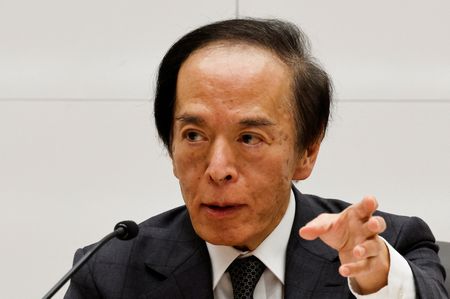(Reuters) -The Bank of Japan kept interest rates steady on Thursday and raised its inflation forecast for the current fiscal year, signalling cautious optimism that Japan’s trade deal with the U.S. would help the economy avert a steep downturn.
As widely expected, the central bank maintained short-term interest rates at 0.5% by a unanimous vote at the two-day policy meeting that ended on Thursday.
Following are excerpts from BOJ Governor Kazuo Ueda’s comments at his post-meeting news conference, which was conducted in Japanese, as translated by Reuters:
INTEREST RATE TRAJECTORY
“If the economy and prices move in line with our forecast, we expect to continue raising interest rates and adjust the degree of monetary support in accordance to improvements in economic and price developments.”
“It’s not as if we will wait until underlying inflation is firmly at 2%. Our decision (on whether to raise rates) is dependent on how likely underlying inflation will reach that level.”
“Given Japan’s trade agreement with the U.S., and deals Washington appears to be striking with other countries, we can say that uncertainty surrounding the outlook as receded. Compared with April, we sharply upgraded this fiscal year’s inflation forecast but left other projections roughly unchanged. We can say that the likelihood (of underlying inflation reaching 2%) has heightened.”
“When we think about downside risks to the economy and its implication on monetary policy, we need to be mindful that our policy interest rate is still low at 0.5%.”
“Tightening monetary policy to deal with too-high inflation works nicely when inflation is driven by strong demand. You can cool over-heated demand and moderate price pressure. But what’s happening in Japan now is price rises driven by supply factors. When you try to deal with such price pressure with monetary tightening, it would hurt the economy, reduce households’ income and weigh on consumption. I’m not sure that’s what people would desire.”
INFLATION OUTLOOK
“Uncertainty surrounding Japan’s economy has receded due to Japan’s trade agreement with the U.S. But there’s no change to our baseline projection that underlying inflation will stagnate for some time due to slowdown in growth. Uncertainty surrounding each country’s trade policy remains high.”
“As for underlying inflation, we will look at various data including people’s perception on prices, long-term inflation expectations … and take a comprehensive assessment on the economy and prices.”
“Underlying inflation still remains short of our 2% target, but expected to rise moderately … The cycle of rising wages and inflation is still maintained.”
“If headline inflation is high for very long, we must be mindful of the risk it could affect underlying inflation.”
IMPACT OF FOOD INFLATION ON BROADER PRICE MOVES
“Rising food prices could hurt consumer sentiment and worsen household spending, or could prolong inflation. I’d like to always keep a close eye out on whether rising food costs could affect inflation expectations and underlying inflation.”
IMPACT OF TARIFFS
“Uncertainty on the rate of tariffs may have receded. But the impact of significantly high U.S. tariffs on the economy is still unclear. I don’t think the fog will clear immediately.”
“I don’t think we’re behind the curve, or that the risk of us being behind the curve is large.”
WAGE CYCLE
“We see rising wages pushing up service prices, and rising prices pushing up wages. That cycle continues. But we don’t think it’s sharply accelerating. That’s why we think we’re not behind the curve. Still, we need to be mindful that headline inflation could affect underlying inflation, and inflation expectations, more than before because underlying inflation is now closer to 2%.”
RECENT YEN MOVES
“Currency moves haven’t deviated much from levels we assumed in setting our price forecasts. As such, I don’t think recent currency moves would immediately have a big impact on our inflation forecasts.”
EXPECTED TIMING OF NEXT RATE HIKE
“One of the keys is whether the cycle of rising wages and inflation, even if the momentum slows somewhat temporarily, continues without being disrupted.”
(Reporting by Leika Kihara; Editing by Janane Venkatraman)











